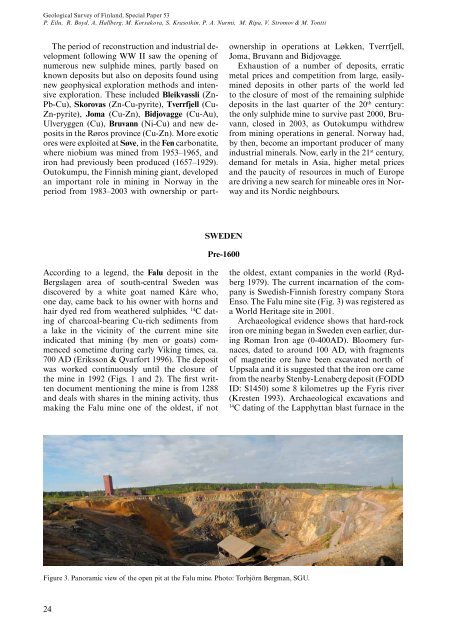Mining history of fennoscandia - arkisto.gsf.fi
Mining history of fennoscandia - arkisto.gsf.fi
Mining history of fennoscandia - arkisto.gsf.fi
You also want an ePaper? Increase the reach of your titles
YUMPU automatically turns print PDFs into web optimized ePapers that Google loves.
Geological Survey <strong>of</strong> Finland, Special Paper 53<br />
P. Eilu, R. Boyd, A, Hallberg, M. Korsakova, S. Krasotkin, P. A. Nurmi, M. Ripa, V. Stromov & M. Tontti<br />
The period <strong>of</strong> reconstruction and industrial development<br />
following WW II saw the opening <strong>of</strong><br />
numerous new sulphide mines, partly based on<br />
known deposits but also on deposits found using<br />
new geophysical exploration methods and intensive<br />
exploration. These included Bleikvassli (Zn-<br />
Pb-Cu), Skorovas (Zn-Cu-pyrite), Tverrfjell (Cu-<br />
Zn-pyrite), Joma (Cu-Zn), Bidjovagge (Cu-Au),<br />
Ulveryggen (Cu), Bruvann (Ni-Cu) and new deposits<br />
in the Røros province (Cu-Zn). More exotic<br />
ores were exploited at Søve, in the Fen carbonatite,<br />
where niobium was mined from 1953–1965, and<br />
iron had previously been produced (1657–1929).<br />
Outokumpu, the Finnish mining giant, developed<br />
an important role in mining in Norway in the<br />
period from 1983–2003 with ownership or part-<br />
According to a legend, the Falu deposit in the<br />
Bergslagen area <strong>of</strong> south-central Sweden was<br />
discovered by a white goat named Kåre who,<br />
one day, came back to his owner with horns and<br />
hair dyed red from weathered sulphides. 14 C dating<br />
<strong>of</strong> charcoal-bearing Cu-rich sediments from<br />
a lake in the vicinity <strong>of</strong> the current mine site<br />
indicated that mining (by men or goats) commenced<br />
sometime during early Viking times, ca.<br />
700 AD (Eriksson & Qvarfort 1996). The deposit<br />
was worked continuously until the closure <strong>of</strong><br />
the mine in 1992 (Figs. 1 and 2). The <strong>fi</strong>rst written<br />
document mentioning the mine is from 1288<br />
and deals with shares in the mining activity, thus<br />
making the Falu mine one <strong>of</strong> the oldest, if not<br />
24<br />
SwEdEN<br />
Pre-1600<br />
Figure 3. Panoramic view <strong>of</strong> the open pit at the Falu mine. Photo: Torbjörn Bergman, SGU.<br />
ownership in operations at Løkken, Tverrfjell,<br />
Joma, Bruvann and Bidjovagge.<br />
Exhaustion <strong>of</strong> a number <strong>of</strong> deposits, erratic<br />
metal prices and competition from large, easilymined<br />
deposits in other parts <strong>of</strong> the world led<br />
to the closure <strong>of</strong> most <strong>of</strong> the remaining sulphide<br />
deposits in the last quarter <strong>of</strong> the 20 th century:<br />
the only sulphide mine to survive past 2000, Bruvann,<br />
closed in 2003, as Outokumpu withdrew<br />
from mining operations in general. Norway had,<br />
by then, become an important producer <strong>of</strong> many<br />
industrial minerals. Now, early in the 21 st century,<br />
demand for metals in Asia, higher metal prices<br />
and the paucity <strong>of</strong> resources in much <strong>of</strong> Europe<br />
are driving a new search for mineable ores in Norway<br />
and its Nordic neighbours.<br />
the oldest, extant companies in the world (Ryd-<br />
berg 1979). The current incarnation <strong>of</strong> the company<br />
is Swedish-Finnish forestry company Stora<br />
Enso. The Falu mine site (Fig. 3) was registered as<br />
a World Heritage site in 2001.<br />
Archaeological evidence shows that hard-rock<br />
iron ore mining began in Sweden even earlier, during<br />
Roman Iron age (0-400AD). Bloomery furnaces,<br />
dated to around 100 AD, with fragments<br />
<strong>of</strong> magnetite ore have been excavated north <strong>of</strong><br />
Uppsala and it is suggested that the iron ore came<br />
from the nearby Stenby-Lenaberg deposit (FODD<br />
ID: S1450) some 8 kilometres up the Fyris river<br />
(Kresten 1993). Archaeological excavations and<br />
14 C dating <strong>of</strong> the Lapphyttan blast furnace in the

















